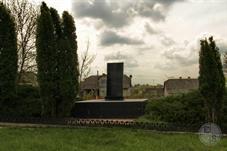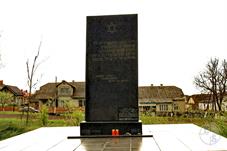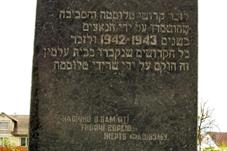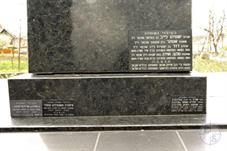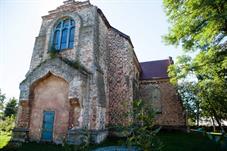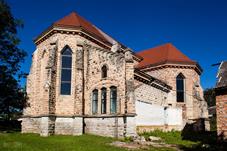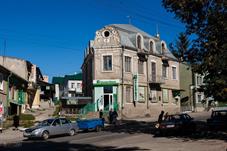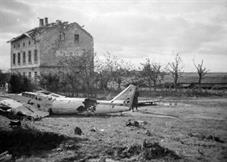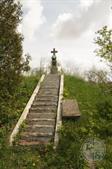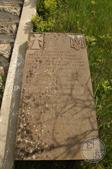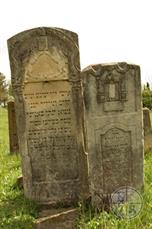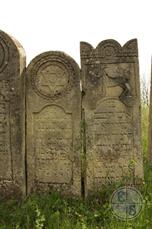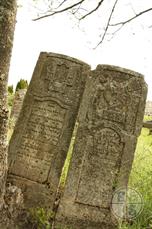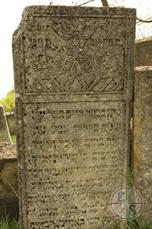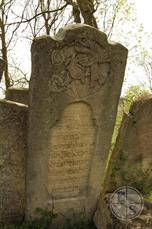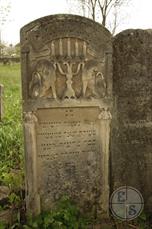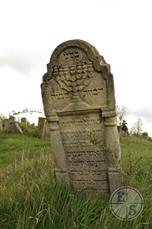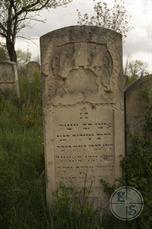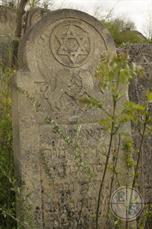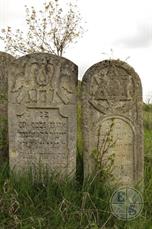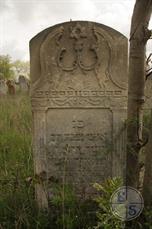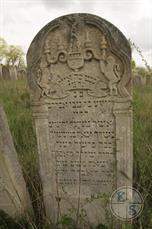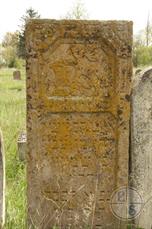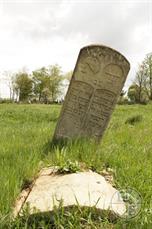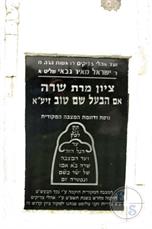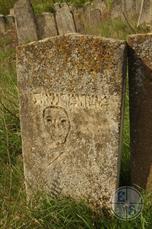Tovste
Tovste, 2016
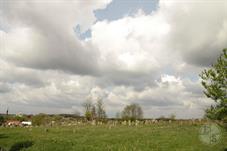 |
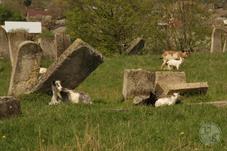 |
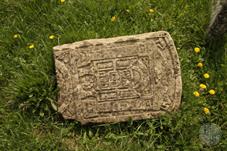 |
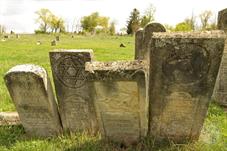 |
| Jewish cemetery | |||
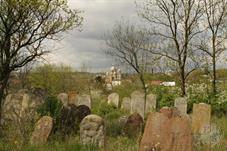 |
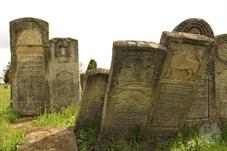 |
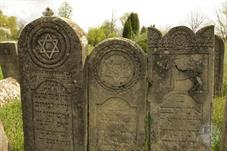 |
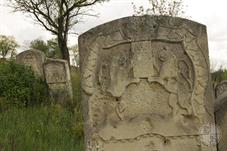 |
| With a view of the St. Michael's Church of 1912 | |||
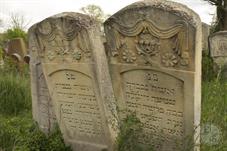 |
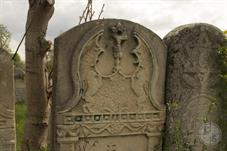 |
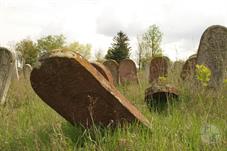 |
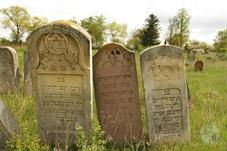 |
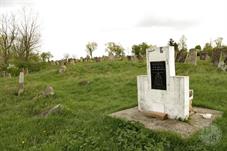 |
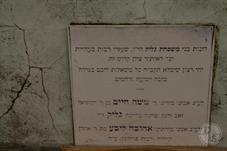 |
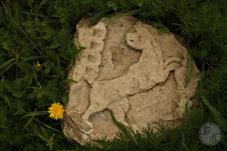 |
 |
| The grave of the mother of Baal Shem Tov |
Ternopil region
In the 16th century, Tluste (ukr. Tovste) was privately owned by the aristocracy. In 1549, the town's owner, Privilgya, received an order from the king of Poland to charge road taxes. In 1571, the town was allowed to hold a yearly fair and a weekly market day. Despite the fact that it was ranked as a town, its gentile residents continued with their agricultural work. During the Russian occupation and during the First World War, the town was set on fire and almost all of the buildings were destroyed.
The first Jewish settlers arrived in Tluste at the end of the 17th century. From the first days of the establishment of the community, most of Tluste's Jews earned their livelihood trading in agriculture products, mostly in grain. A number of families engaged in the production of spirits. The center of the economical activity was market day which was held on Thursday. On that day the farmers from the nearby villages sold their agricultural products to the Jews, and purchased all the consumer goods from them with their profits. The warehouses for grain, eggs and wood were under Jewish ownership. In 1899 the railroad was inaugurated in the town and helped to increase agricultural exports to Germany.
Most of the essential trades in Tluste were in Jewish hands: shoemaking, tailoring, glaziery, tanning and metal work. At the beginning of the 20th century, the Jews established factories for the production of socks, fabric, hairnets and also sewing workshops for underwear. All the taverns in the town, prior to the First World War, were in Jewish hands. At the same period of time, “Gemilut Hasadim” [a charitable fund] was established in the town and also assisted Jews in the nearby villages. In 1913 the fund gave loans to 1,301 needy persons in the town and the surrounding area. Registered in the fund were: 874 merchants, 242 tradesmen, 80 farmers and 260 who did not have a specific occupation. Before 1914 there was only one Jewish doctor, one pharmacy and also one Jewish veterinarian.
During the First World War and Ukrainian rule during the latter part of the war, the economic situation of the Tluste's Jews totally weakened. A large number of factories and business were destroyed, and it was necessary to rebuild the Jewish economy from the foundation up. From the beginning of the 20th century Jewish economic activities gradually increased.
The first Jewish settlers arrived in Tluste at the end of the 17th century. From the first days of the establishment of the community, most of Tluste's Jews earned their livelihood trading in agriculture products, mostly in grain. A number of families engaged in the production of spirits. The center of the economical activity was market day which was held on Thursday. On that day the farmers from the nearby villages sold their agricultural products to the Jews, and purchased all the consumer goods from them with their profits. The warehouses for grain, eggs and wood were under Jewish ownership. In 1899 the railroad was inaugurated in the town and helped to increase agricultural exports to Germany.
Most of the essential trades in Tluste were in Jewish hands: shoemaking, tailoring, glaziery, tanning and metal work. At the beginning of the 20th century, the Jews established factories for the production of socks, fabric, hairnets and also sewing workshops for underwear. All the taverns in the town, prior to the First World War, were in Jewish hands. At the same period of time, “Gemilut Hasadim” [a charitable fund] was established in the town and also assisted Jews in the nearby villages. In 1913 the fund gave loans to 1,301 needy persons in the town and the surrounding area. Registered in the fund were: 874 merchants, 242 tradesmen, 80 farmers and 260 who did not have a specific occupation. Before 1914 there was only one Jewish doctor, one pharmacy and also one Jewish veterinarian.
During the First World War and Ukrainian rule during the latter part of the war, the economic situation of the Tluste's Jews totally weakened. A large number of factories and business were destroyed, and it was necessary to rebuild the Jewish economy from the foundation up. From the beginning of the 20th century Jewish economic activities gradually increased.
In 1925, 18 tradesmen, 85 small merchants, 32 wholesale merchants and factory owners, and 13 farmers were registered in the Jewish “Credit Union”. In 1928 there were 400 members in this union and 500 loans totaling around 200,000 Zloty were given. In 1937, 71 tradesmen, 207 small merchants, 36 salaried employees, 17 farmers and 27 without a designated trade, a total of 558 members were registered and given financial help by the union. Jewish building contractors built homes in the town and in the surrounding area. In 1931 a Jewish builder built the central power station in Tluste. In 1937 a factory for cement and masonry stone for artistic coating was established under Jewish ownership. In Tluste there were unions for small merchants and Jewish farmers, the union “Yad Harutzim” [Hand of the Diligent Men] organized most of the Jewish tradesmen in town. The discriminating economic policy of the Polish authorities placed a heavy weight on Tluste's Jews, and many factories and stores had to close due to the heavy burden of taxes, and the difficult competition from Poles who were supported by the authorities. In 1937, the licenses were renewed but only to the owners of 3 Jewish butcher shops out of the 12 butcher shops in town.
During the second half of the 1930s there were 4 Jewish doctors, 6 lawyers and one judge; and the economic distress increased. The community institutions and public organization ran public kitchens and distributed food and clothing to the needy. In 1938 a charitable organization for widows and orphans was established, and Tluste's Landsmannschaft organization in New York sent regular contributions to help the needy. By doing so, 236 families were helped by this fund in 1939.
During the last years before the Second World War, a number of families immigrated to Argentina, Ecuador and Costa Rica.
For a number of generations since the founding of Jewish Tluste, the community did not have a rabbi and was a subordinate of the Chortkov [Czortków] community. One of Tluste's first rabbis was Rabbi Dov Bartsi Shapira, son-in-law of the Admor Rabbi Chaim from Kosov, who influenced his election to this position. After his death in 1850, Rabbi Avraham Heshil sat on the rabbinical chair. In 1894 Rabbi Pinchas Chodorov was nominated as Tluste's rabbi. He died in the cholera epidemic of 1915. Tluste's last rabbi was the son of Rabbi Pinchas, Rabbi Shmuel-Aba Chodorov, who perished in the holocaust.
Tluste is connected to the creation of the Hassidut movement. According to stories, Ba'al Shem Tov lived there in the years 1730-1740. Also in later periods there were different Hassidic streams in town. Since the end of the 19th century most of Tluste's Jews belonged to one of three Admorim: Chortkov, Vizhnitz, and Kopyczynce. Each one of these groups had their own kloiz [synagogue], the largest one belonged to the Chortkov Hassidim.
The different Hassidic groups struggled among themselves for control of the community organizations. During the first years of the 20th century, the community committee was composed of Vizhnitz Hassidim and lead by Chaim Nagler. In the 1908 and 1913 elections, the struggle between the Vizhnitz and the Chortkov Hassidim continued, and in 1913 the Chortkov Hassidim gained control of the community committee. Baruch-Yitschak Vitashka was elected as the community leader.
At the end of the First World War, the committee renewed its activities and was in the hands of “Agudat Yisrael” [the Jewish union]. This situation continued until 1933, when a consolidated list was created for the community committee and included 4 representatives from “Agudat Yisrael” and 4 representatives from the Zionist political parties. The Union political party was not a partner to this arrangement. The community leader was Meir Kleiner from “Agudat Yisrael” who was elected again in the 1937 elections. In December of 1938, the community committee was dissolved by the Polish authorities who nominated Yitschak Kazner as a commissioner.
The financial situation of the community organizations between the two world wars was difficult. The independent sources of income were drastically reduced. In a period of 6 years, from 1928 to 1934, the community almost did not collect direct taxes. Most of the income came from indirect taxes, mostly from slaughtering. In 1938 the community's income was only 23,129 Zloty. The income from slaughtering was 14,000 Zloty and from direct taxes 7,054 Zloty. From this budget, 400 Zloty were allocated to cultural activities, 800 Zloty for the upkeep of the homeless shelter, 450 to the institution for deaf and mute children, and 1,300 Zloty to aid organizations.
Even the municipality of Tluste gradually reduced its support of the Jewish organizations until it completely canceled it. For example, in 1931 the town's budget allocated the amount of 100 Zloty to cultural Jewish activities, 100 Zloty to “Talmud Torah”, 50 Zloty to the sport's organization “Macabi”, and 50 Zloty to “Gemilut Hassdim”.
In the 1930s, the community operated a mother and child advisory and care clinic, “Bikur Holim” [visiting of the sick] provided help to the sick and poor, and “Agudath Nashim” [association for women] took part in helping the needy.
In 1934, two Jewish representatives were elected to the town council, and B.Y. Vitashka served as deputy mayor. In 1939, under the pressure of the Polish authorities, the election to the town council was canceled. An agreement was made among the residents of Tluste that the make-up of the council would be: 7 Poles, 3 Jews and 2 Ukrainians.
At the end of the 19th century, there were only a few Zionist groups in town. In 1906 there were two Zionist societies: “Tikvat Zion” [hope of Zion] for men, and “Ruth” for women. In 1912 the “Social Jewish society” was established, and it was connected to the social Jewish political party in Galicia.
Extensive political activity began in Tluste between the two world wars: In 1923 a chapter of “Achdut” [union] was founded, and by1934 it had 69 members. There were also branches of: the General Zionists Movement, the Revisionist movement, the country political party (after 1933) and “Mizrachi” [Religious Zionism]. Zionist women were organized in “WIZO” [Women's International Zionist Organization]. Between 1920-1939, the following youth movements were active in Tluste: “Hehalutz” [pioneer], “Hehalutz Hatza'ir “[young pioneers], “Achva”, [brotherhood], “Hashomer Hatza'ir” [Young Guardsmen], “Gordonia” [Zionist pioneering youth movement], “Buslia”,” Betar” [Revisionist Zionist youth movement] (from 1929, the number of members in 1933 was 40), and “Young WIZO”. At the end of the 1930s, all the Zionist Youth Movements in Tluste organized themselves under one roof, under the name “The youth treaty”.
During the second half of the 1930s there were 4 Jewish doctors, 6 lawyers and one judge; and the economic distress increased. The community institutions and public organization ran public kitchens and distributed food and clothing to the needy. In 1938 a charitable organization for widows and orphans was established, and Tluste's Landsmannschaft organization in New York sent regular contributions to help the needy. By doing so, 236 families were helped by this fund in 1939.
During the last years before the Second World War, a number of families immigrated to Argentina, Ecuador and Costa Rica.
For a number of generations since the founding of Jewish Tluste, the community did not have a rabbi and was a subordinate of the Chortkov [Czortków] community. One of Tluste's first rabbis was Rabbi Dov Bartsi Shapira, son-in-law of the Admor Rabbi Chaim from Kosov, who influenced his election to this position. After his death in 1850, Rabbi Avraham Heshil sat on the rabbinical chair. In 1894 Rabbi Pinchas Chodorov was nominated as Tluste's rabbi. He died in the cholera epidemic of 1915. Tluste's last rabbi was the son of Rabbi Pinchas, Rabbi Shmuel-Aba Chodorov, who perished in the holocaust.
Tluste is connected to the creation of the Hassidut movement. According to stories, Ba'al Shem Tov lived there in the years 1730-1740. Also in later periods there were different Hassidic streams in town. Since the end of the 19th century most of Tluste's Jews belonged to one of three Admorim: Chortkov, Vizhnitz, and Kopyczynce. Each one of these groups had their own kloiz [synagogue], the largest one belonged to the Chortkov Hassidim.
The different Hassidic groups struggled among themselves for control of the community organizations. During the first years of the 20th century, the community committee was composed of Vizhnitz Hassidim and lead by Chaim Nagler. In the 1908 and 1913 elections, the struggle between the Vizhnitz and the Chortkov Hassidim continued, and in 1913 the Chortkov Hassidim gained control of the community committee. Baruch-Yitschak Vitashka was elected as the community leader.
At the end of the First World War, the committee renewed its activities and was in the hands of “Agudat Yisrael” [the Jewish union]. This situation continued until 1933, when a consolidated list was created for the community committee and included 4 representatives from “Agudat Yisrael” and 4 representatives from the Zionist political parties. The Union political party was not a partner to this arrangement. The community leader was Meir Kleiner from “Agudat Yisrael” who was elected again in the 1937 elections. In December of 1938, the community committee was dissolved by the Polish authorities who nominated Yitschak Kazner as a commissioner.
The financial situation of the community organizations between the two world wars was difficult. The independent sources of income were drastically reduced. In a period of 6 years, from 1928 to 1934, the community almost did not collect direct taxes. Most of the income came from indirect taxes, mostly from slaughtering. In 1938 the community's income was only 23,129 Zloty. The income from slaughtering was 14,000 Zloty and from direct taxes 7,054 Zloty. From this budget, 400 Zloty were allocated to cultural activities, 800 Zloty for the upkeep of the homeless shelter, 450 to the institution for deaf and mute children, and 1,300 Zloty to aid organizations.
Even the municipality of Tluste gradually reduced its support of the Jewish organizations until it completely canceled it. For example, in 1931 the town's budget allocated the amount of 100 Zloty to cultural Jewish activities, 100 Zloty to “Talmud Torah”, 50 Zloty to the sport's organization “Macabi”, and 50 Zloty to “Gemilut Hassdim”.
In the 1930s, the community operated a mother and child advisory and care clinic, “Bikur Holim” [visiting of the sick] provided help to the sick and poor, and “Agudath Nashim” [association for women] took part in helping the needy.
In 1934, two Jewish representatives were elected to the town council, and B.Y. Vitashka served as deputy mayor. In 1939, under the pressure of the Polish authorities, the election to the town council was canceled. An agreement was made among the residents of Tluste that the make-up of the council would be: 7 Poles, 3 Jews and 2 Ukrainians.
At the end of the 19th century, there were only a few Zionist groups in town. In 1906 there were two Zionist societies: “Tikvat Zion” [hope of Zion] for men, and “Ruth” for women. In 1912 the “Social Jewish society” was established, and it was connected to the social Jewish political party in Galicia.
Extensive political activity began in Tluste between the two world wars: In 1923 a chapter of “Achdut” [union] was founded, and by1934 it had 69 members. There were also branches of: the General Zionists Movement, the Revisionist movement, the country political party (after 1933) and “Mizrachi” [Religious Zionism]. Zionist women were organized in “WIZO” [Women's International Zionist Organization]. Between 1920-1939, the following youth movements were active in Tluste: “Hehalutz” [pioneer], “Hehalutz Hatza'ir “[young pioneers], “Achva”, [brotherhood], “Hashomer Hatza'ir” [Young Guardsmen], “Gordonia” [Zionist pioneering youth movement], “Buslia”,” Betar” [Revisionist Zionist youth movement] (from 1929, the number of members in 1933 was 40), and “Young WIZO”. At the end of the 1930s, all the Zionist Youth Movements in Tluste organized themselves under one roof, under the name “The youth treaty”.
In addition to the Zionist political parties, branches of “Agudat Yisrael” and “Bond” were also active in Tluste.
At the beginning of the 20th century, a school founded by Baron Hirsh was opened in Tluste. In addition, classes in Hebrew and a nursery school existed before 1914. In the years 1923-1924, classes were organized by the “Jewish organization for elementary and high schools” in Lvov. Between the two world wars, “Agudat Yisrael” established the school for girls “Beit Yakov”. At the same time the Hebrew school renewed its activities under the sponsorship of the “Tarbut” organization. Most of the time there was only one class and, at its peak, about 90 students studied there. In 1936 a private Jewish vocational high school was opened.
Henrik Biglayzen was born in Tluste in 1855 (grandson of Nachman Krochmel). He was a science-fiction book collector and publisher. He researched among others the writings of Mitzkivetz and Slovatzki. Dr. Devaver (Bernard) Wachstein, who was born in Tluste (1868-1935), was a researcher in the history of Austrian Jews. Some of his publications are: “Inscriptions in the old cemetery in Vienna” and “Collection of documents from the ancient Jewish community of Eisenstadt”. In 1939, Wachstein donated one of his research books “The history of the Jews in Moravia”.
The Jewish poet, Shimshon Meltzer, was born in Tluste on 1909. His first Yiddish poems were published in different periodicals in eastern Galicia. He emigrated to Israel in 1933 and memorialized the community of Tluste in his works.
In the 1930s, the Polish and the Ukrainian populations increased their anti-Semitic attacks on Tluste's Jews. In October 1936, Jewish merchants who traveled for their business to the nearby villages were attacked. In December of that year, attacks against the Jews who lived in the nearby villages and in Tluste continued and gangs broke windows in Jewish homes. In 1937, Polish and Ukrainian nationalists wanted to expel the Jewish farmers from the villages in the Tluste region. The farmers organized a committee to stop this scheme, but the attacks by the anti-Semite circles continued until the outbreak of the war in September of 1939.
At the beginning of the 20th century, a school founded by Baron Hirsh was opened in Tluste. In addition, classes in Hebrew and a nursery school existed before 1914. In the years 1923-1924, classes were organized by the “Jewish organization for elementary and high schools” in Lvov. Between the two world wars, “Agudat Yisrael” established the school for girls “Beit Yakov”. At the same time the Hebrew school renewed its activities under the sponsorship of the “Tarbut” organization. Most of the time there was only one class and, at its peak, about 90 students studied there. In 1936 a private Jewish vocational high school was opened.
Henrik Biglayzen was born in Tluste in 1855 (grandson of Nachman Krochmel). He was a science-fiction book collector and publisher. He researched among others the writings of Mitzkivetz and Slovatzki. Dr. Devaver (Bernard) Wachstein, who was born in Tluste (1868-1935), was a researcher in the history of Austrian Jews. Some of his publications are: “Inscriptions in the old cemetery in Vienna” and “Collection of documents from the ancient Jewish community of Eisenstadt”. In 1939, Wachstein donated one of his research books “The history of the Jews in Moravia”.
The Jewish poet, Shimshon Meltzer, was born in Tluste on 1909. His first Yiddish poems were published in different periodicals in eastern Galicia. He emigrated to Israel in 1933 and memorialized the community of Tluste in his works.
In the 1930s, the Polish and the Ukrainian populations increased their anti-Semitic attacks on Tluste's Jews. In October 1936, Jewish merchants who traveled for their business to the nearby villages were attacked. In December of that year, attacks against the Jews who lived in the nearby villages and in Tluste continued and gangs broke windows in Jewish homes. In 1937, Polish and Ukrainian nationalists wanted to expel the Jewish farmers from the villages in the Tluste region. The farmers organized a committee to stop this scheme, but the attacks by the anti-Semite circles continued until the outbreak of the war in September of 1939.
During the first half of September 1939, Tluste was an important crossing point for refugees from western Poland who tried to reach the Romanian border. The Jewish community gave a helping hand to the Jewish refugees who passed through the town or stopped there. On 17.8.1939, the town was captured by the Soviet army. At first, the small Jewish merchants were allowed to continue with their businesses, but in time due to the heavy toll of taxes most of them closed their stores. The warehouses that belonged to the big merchants were confiscated. Jewish tradesmen were asked to organize in cooperatives, but most of them continued to work privately in their homes. The Jews integrated in the municipal and national administration and fulfilled important duties in the network of cooperative stores. The community's institutions were closed and the Jewish community life officially continued in the synagogues. Jewish refugees from western Poland who found shelter in Tluste were expelled in the summer of 1940 to the USSR.
When war between Germany and the USSR broke out, young Jewish men were drafted to the Red Army. Because of the swift collapse of the Soviet battlefront and the news about the evacuation of the town, Jewish groups were organized and people planned to escape to the Russian interior, but only a few were able to do so. The tension between Jews and Ukrainians was already felt during the days before the Soviet retreat, but moderate groups among the Ukrainians calmed the Jewish population.
On 6.7.1941, the last Soviet soldiers left town. On the next day, the Ukrainians attacked Jews in the nearby villages and killed close to 200 people. The rioters also tried to enter Tluste, but thanks to the intervention of the local Ukrainian priest, Izobolskei [Navolskyy – ed.], the matter was prevented. The Polish priest also joined the efforts to prevent riots against the Jews by the Polish population.
On 9.7.1941, Hungarian military units, the German allies, entered Tluste. Their attitude towards the Jews was moderate, despite the fact that Jewish property was stolen by Hungarian soldiers. One Hungarian cavalry unit housed their horses in Beit Ha'Midrash, and desecrated ritual articles. They also ordered the Jews to hand over their radios and started to abduct people for forced labor.
On 1.8.1941, around 2,000 Jews who were exiled by the Hungarian authorities from Karpatorus reached Tluste. Tluste's Jews established a committee of 12 people to organize help for the refugees. They provided them with a roof over their heads and hot meals. The refugees stayed in Tluste for three weeks and later on they were led to Kamieniec-Podolski where most of them were murdered.
On 1.9.1941, the town was transferred to the direct control of the Germans. On the same day a number of decrees were enforced on the Jews: each Jew from the age of 12 had to wear a white ribbon with a blue Star of David, and Jews were forbidden to walk in the main street or leave the town's boundaries. At first, the Jews were allowed to purchase food in the market for an hour each day, but later on they were not allowed to come to the market square.
In September 1941, the Germans ordered the establishment of a Judenrat [Jewish council]. Yakov Pal was elected as the Judenrat leader; up to that time he had organized the local refugee aid committee. At this stage the Gestapo in Chortkov was in charge of Tluste's Jewish matters. Every once in a while, they came to the town and spread fear among the Judenrat and the Jewish community. At first the Judenrat was instructed to provide workers for forced labor, to hand over valuables and to arrange a census of the Jewish population. A member of the Judenrat, Leon Krasutski, was the liaison between the Jewish council and the Gestapo in Chortkov. A Jewish police force of 20 people operated alongside the Judenrat. A number of Judenrat members refused to continue with their duties in the council because of the difficulties in fulfilling the Germans' demands. Indeed, personnel changes occurred in the council's make-up but Yakov Pal remained as the council's leader.
In the fall of 1941, the Judenrat ran a community kitchen that was managed by a number of prominent public figures, among them were Yosef Shechter and David Bronshtayn. In order to secure the kitchen's operation, a special tax was enforced on the wealthy community members. They also managed to operate a kosher kitchen under the difficult conditions of the German occupation. The kitchen fulfilled an important part in easing the difficulties of Tluste's Jews during the winter of 1941-1942.
In November 1941, the Judenrat was instructed to supply Jews to work on the agricultural farms and in the labor camps in the area. Some of the workers were employed in 23 agricultural farms between Tluste and Chortkov that were under the management of the “G.G. Caoutchouc” company. This company grew a plant that was used for the production of rubber. The farms' management promised good conditions for the Jews, and the Judenrat supplied around 300-400 workers for this purpose. Due to the somewhat good conditions, the Judenrat was interested to increase the number of workers on those farms, but were faced with the objection of the Gestapo in Chortkov. Other groups of Tluste's Jews were sent to labor camps in Kamionka, Hluboczek and Borki-Wielki near Tarnopol, where they were subjected to hard labor, humiliation, hunger and murder.
At the beginning of December 1941, the abductions to labor camps continued. After Tluste's Jews discovered the fate of those who were sent to labor camps, they did not respond to the Judenrat's call and did all they could do to evade it and hide. In addition, Gestapo men arrived every once in a while from Chortkov and abducted tens of Jews to the camps. On 20.12.1941, 120 of Tluste's Jews were sent to camps. Among them were three members of the Judenrat: Krasutski, Moshe Pfeffer and Yisrael Krampf. A number of people from this group, including the members of the Judenrat, were released thanks to a large sum of ransom money and the mediation of the Skalat Judenrat.
In December 1941, Tluste's Jews were ordered to hand over, in a period of two weeks, all the furs in their possession. A number of Jews were taken as hostages in order to secure the fulfillment of this demand. Most of the members of the community gave their furs, but there were those who opted to destroy their furs and not give them to the Germans. And so, the Germans continued to demand expensive merchandise from the Jews - jewelry, silver items, leather coats, boots and fabrics.
In December 1942, Yakov Pal resigned from his duty as the Judenrat leader and Averman, from Yahilnytsa [Jagielnica] was nominated in his place. Survivors' evaluations of the two Judenrat leaders indicate that the two tried to ease the conditions of the members of the community and put the public interest above their personal needs.
In February 1942, the management of the agricultural farms was transferred to the hands of the German army, and the demand for additional workers increased. The farms' managers requested that their workers be given certain immunity. This request caused tension between them and the Gestapo in Chortkov.
On July 1942, the Germans demanded to hand over 10% of the total members of the community, those who were unable to work and those who needed financial aid. In the same month, 200 sick elderly were caught. To complete the quota, the Germans brought 75 young Jewish women, who worked in the Kozia-Gora farm near Tluste, and all of them were sent for extermination, probably to the Belzec concentration camp. After this “Aktzya” the Jews increased their efforts to find secure working places, mostly on the agricultural farms where the managers refused to hand over their workers for extermination. In the town, the Jews prepared well-concealed hiding places and hoped to find shelter in them during the “Aktzyot”.
During the summer months of 1942, Jewish groups from the surrounding towns and villages, such as Horodnitca [Horodenka], Zalishchyky [Zaleszczyki], Hinkovtza [Hińkowce] and Laskovitz [Ułaszkowce], were transferred to Tluste.
Tluste's second “Aktzya” started on 5.10.1942. The Germans, with the help of the Ukrainian police, collected around 1,000 people and sent them for extermination to Belzec. Hundreds were murdered in Tluste's streets, among them many babies who were murdered by the Germans and their helpers on the spot. At the end of the “Aktzya” the victims were buried in a mass grave in Tluste's cemetery.
At the beginning of October 1942, the surviving Jews in the Chortkov region were permitted to settle in four towns: Buczacz, Borszczуw, Kopychintsy [Kopyczyńce], and Tluste. And so, Jews who were evicted from other towns in the area started to arrive in Tluste. At the same time, the abduction of Jews to labor camps continued in Tluste. The winter of 1942-1943 brought diseases, and many died from typhus and starvation. The “visits” of the Gestapo men from Chortkov in Tluste were so frequent that it was impossible to go out in the streets. They suddenly arrived, entered Jewish homes, and shot Jews in their homes or in their yards. During the winter and spring months of 1943, Jews were abducted on Tluste's streets or in their homes, sent to the central prison in Chortkov, and from there they were added to extermination transports.
In April 1943, the German army received permission from the Gestapo to employ 1,500 Jews on agricultural farms. For that, camps were built in the villages: Swidowa, Rozanovka [Rуżanуwka], Kozia-Gora, Holovzinza [Hołowczyńce], Shipovtza [Szypowce] and Shasnivtza [Szerszeniowce]. Tluste's Jews assumed that they would be able to stay there until the end of the agriculture season, and a few hundred left for these camps.
On 27.5.1943, the third “Aktzya” started. Before morning the sound of gunfire was heard and 600 German policemen, who were assisted by the Ukrainian police, surrounded the town and blocked all the exit roads. Around 3,000 people were assembled in the market square. Later on they were led in groups of 100-200 people to the cemetery where they were shot and buried in a mass grave. After this murder, the Germans killed the 70 young Jewish men who had dug the graves and sorted the victims' clothing. Some 800 Jews, who were trying to escape from the Germans, were murdered in the streets. At the end of the “Aktzya” the Jewish police was told to collect the bodies and bury them in the Jewish cemetery.
A week later, an order was given that all the surviving community members must concentrate in a ghetto. In a few hours, around 3,000 people were brought to two streets and housed in a small numbers of buildings. The Jews lived in horrible overcrowded conditions, in starvation and sickness and they feared what was coming next. Many escaped and tried to hide in the forests and with friends among the local population. Since the Jews, who were working in the labor camps and on the agricultural farms were not hurt, many of Tluste's Jews left the ghetto for the camps and the farms.
On 5.6.1943, the ghetto was closed and the Jewish police was ordered to prevent the Jews from leaving its boundaries. On the next day, a number of cars loaded with Gestapo men and Ukrainian policemen arrived in Tluste. They broke into the ghetto and started to collect all the Jews who lived there. The Germans and the Ukrainians tried to find the hiding places. They pulled out floor boards, broke walls and also set homes on fire. All the Jews who were caught were sent to the cemetery and murdered there. The bloodshed on that day reached to more than 1,000 people. After the slaughter, a group of Jews left for the agriculture farms and the 120 people who remained in the town moved to a number of homes in the ghetto.
On 9.6.1943, the last of Tluste's Jews were transferred to Chortkov where they were exterminated. The town was declared “Judenrein” (“free of Jews”).
A few surviving members of the Judenrat and the Jewish police were able, with the help of Ukrainian friends, to cross to Romania. At the end their journey their Ukrainian guide handed them to the Romanian police who brought them to Zalishchyky [Zaleszczyki]. They were handed over to the Germans who murdered them after robbing their possessions.
When war between Germany and the USSR broke out, young Jewish men were drafted to the Red Army. Because of the swift collapse of the Soviet battlefront and the news about the evacuation of the town, Jewish groups were organized and people planned to escape to the Russian interior, but only a few were able to do so. The tension between Jews and Ukrainians was already felt during the days before the Soviet retreat, but moderate groups among the Ukrainians calmed the Jewish population.
On 6.7.1941, the last Soviet soldiers left town. On the next day, the Ukrainians attacked Jews in the nearby villages and killed close to 200 people. The rioters also tried to enter Tluste, but thanks to the intervention of the local Ukrainian priest, Izobolskei [Navolskyy – ed.], the matter was prevented. The Polish priest also joined the efforts to prevent riots against the Jews by the Polish population.
On 9.7.1941, Hungarian military units, the German allies, entered Tluste. Their attitude towards the Jews was moderate, despite the fact that Jewish property was stolen by Hungarian soldiers. One Hungarian cavalry unit housed their horses in Beit Ha'Midrash, and desecrated ritual articles. They also ordered the Jews to hand over their radios and started to abduct people for forced labor.
On 1.8.1941, around 2,000 Jews who were exiled by the Hungarian authorities from Karpatorus reached Tluste. Tluste's Jews established a committee of 12 people to organize help for the refugees. They provided them with a roof over their heads and hot meals. The refugees stayed in Tluste for three weeks and later on they were led to Kamieniec-Podolski where most of them were murdered.
On 1.9.1941, the town was transferred to the direct control of the Germans. On the same day a number of decrees were enforced on the Jews: each Jew from the age of 12 had to wear a white ribbon with a blue Star of David, and Jews were forbidden to walk in the main street or leave the town's boundaries. At first, the Jews were allowed to purchase food in the market for an hour each day, but later on they were not allowed to come to the market square.
In September 1941, the Germans ordered the establishment of a Judenrat [Jewish council]. Yakov Pal was elected as the Judenrat leader; up to that time he had organized the local refugee aid committee. At this stage the Gestapo in Chortkov was in charge of Tluste's Jewish matters. Every once in a while, they came to the town and spread fear among the Judenrat and the Jewish community. At first the Judenrat was instructed to provide workers for forced labor, to hand over valuables and to arrange a census of the Jewish population. A member of the Judenrat, Leon Krasutski, was the liaison between the Jewish council and the Gestapo in Chortkov. A Jewish police force of 20 people operated alongside the Judenrat. A number of Judenrat members refused to continue with their duties in the council because of the difficulties in fulfilling the Germans' demands. Indeed, personnel changes occurred in the council's make-up but Yakov Pal remained as the council's leader.
In the fall of 1941, the Judenrat ran a community kitchen that was managed by a number of prominent public figures, among them were Yosef Shechter and David Bronshtayn. In order to secure the kitchen's operation, a special tax was enforced on the wealthy community members. They also managed to operate a kosher kitchen under the difficult conditions of the German occupation. The kitchen fulfilled an important part in easing the difficulties of Tluste's Jews during the winter of 1941-1942.
In November 1941, the Judenrat was instructed to supply Jews to work on the agricultural farms and in the labor camps in the area. Some of the workers were employed in 23 agricultural farms between Tluste and Chortkov that were under the management of the “G.G. Caoutchouc” company. This company grew a plant that was used for the production of rubber. The farms' management promised good conditions for the Jews, and the Judenrat supplied around 300-400 workers for this purpose. Due to the somewhat good conditions, the Judenrat was interested to increase the number of workers on those farms, but were faced with the objection of the Gestapo in Chortkov. Other groups of Tluste's Jews were sent to labor camps in Kamionka, Hluboczek and Borki-Wielki near Tarnopol, where they were subjected to hard labor, humiliation, hunger and murder.
At the beginning of December 1941, the abductions to labor camps continued. After Tluste's Jews discovered the fate of those who were sent to labor camps, they did not respond to the Judenrat's call and did all they could do to evade it and hide. In addition, Gestapo men arrived every once in a while from Chortkov and abducted tens of Jews to the camps. On 20.12.1941, 120 of Tluste's Jews were sent to camps. Among them were three members of the Judenrat: Krasutski, Moshe Pfeffer and Yisrael Krampf. A number of people from this group, including the members of the Judenrat, were released thanks to a large sum of ransom money and the mediation of the Skalat Judenrat.
In December 1941, Tluste's Jews were ordered to hand over, in a period of two weeks, all the furs in their possession. A number of Jews were taken as hostages in order to secure the fulfillment of this demand. Most of the members of the community gave their furs, but there were those who opted to destroy their furs and not give them to the Germans. And so, the Germans continued to demand expensive merchandise from the Jews - jewelry, silver items, leather coats, boots and fabrics.
In December 1942, Yakov Pal resigned from his duty as the Judenrat leader and Averman, from Yahilnytsa [Jagielnica] was nominated in his place. Survivors' evaluations of the two Judenrat leaders indicate that the two tried to ease the conditions of the members of the community and put the public interest above their personal needs.
In February 1942, the management of the agricultural farms was transferred to the hands of the German army, and the demand for additional workers increased. The farms' managers requested that their workers be given certain immunity. This request caused tension between them and the Gestapo in Chortkov.
On July 1942, the Germans demanded to hand over 10% of the total members of the community, those who were unable to work and those who needed financial aid. In the same month, 200 sick elderly were caught. To complete the quota, the Germans brought 75 young Jewish women, who worked in the Kozia-Gora farm near Tluste, and all of them were sent for extermination, probably to the Belzec concentration camp. After this “Aktzya” the Jews increased their efforts to find secure working places, mostly on the agricultural farms where the managers refused to hand over their workers for extermination. In the town, the Jews prepared well-concealed hiding places and hoped to find shelter in them during the “Aktzyot”.
During the summer months of 1942, Jewish groups from the surrounding towns and villages, such as Horodnitca [Horodenka], Zalishchyky [Zaleszczyki], Hinkovtza [Hińkowce] and Laskovitz [Ułaszkowce], were transferred to Tluste.
Tluste's second “Aktzya” started on 5.10.1942. The Germans, with the help of the Ukrainian police, collected around 1,000 people and sent them for extermination to Belzec. Hundreds were murdered in Tluste's streets, among them many babies who were murdered by the Germans and their helpers on the spot. At the end of the “Aktzya” the victims were buried in a mass grave in Tluste's cemetery.
At the beginning of October 1942, the surviving Jews in the Chortkov region were permitted to settle in four towns: Buczacz, Borszczуw, Kopychintsy [Kopyczyńce], and Tluste. And so, Jews who were evicted from other towns in the area started to arrive in Tluste. At the same time, the abduction of Jews to labor camps continued in Tluste. The winter of 1942-1943 brought diseases, and many died from typhus and starvation. The “visits” of the Gestapo men from Chortkov in Tluste were so frequent that it was impossible to go out in the streets. They suddenly arrived, entered Jewish homes, and shot Jews in their homes or in their yards. During the winter and spring months of 1943, Jews were abducted on Tluste's streets or in their homes, sent to the central prison in Chortkov, and from there they were added to extermination transports.
In April 1943, the German army received permission from the Gestapo to employ 1,500 Jews on agricultural farms. For that, camps were built in the villages: Swidowa, Rozanovka [Rуżanуwka], Kozia-Gora, Holovzinza [Hołowczyńce], Shipovtza [Szypowce] and Shasnivtza [Szerszeniowce]. Tluste's Jews assumed that they would be able to stay there until the end of the agriculture season, and a few hundred left for these camps.
On 27.5.1943, the third “Aktzya” started. Before morning the sound of gunfire was heard and 600 German policemen, who were assisted by the Ukrainian police, surrounded the town and blocked all the exit roads. Around 3,000 people were assembled in the market square. Later on they were led in groups of 100-200 people to the cemetery where they were shot and buried in a mass grave. After this murder, the Germans killed the 70 young Jewish men who had dug the graves and sorted the victims' clothing. Some 800 Jews, who were trying to escape from the Germans, were murdered in the streets. At the end of the “Aktzya” the Jewish police was told to collect the bodies and bury them in the Jewish cemetery.
A week later, an order was given that all the surviving community members must concentrate in a ghetto. In a few hours, around 3,000 people were brought to two streets and housed in a small numbers of buildings. The Jews lived in horrible overcrowded conditions, in starvation and sickness and they feared what was coming next. Many escaped and tried to hide in the forests and with friends among the local population. Since the Jews, who were working in the labor camps and on the agricultural farms were not hurt, many of Tluste's Jews left the ghetto for the camps and the farms.
On 5.6.1943, the ghetto was closed and the Jewish police was ordered to prevent the Jews from leaving its boundaries. On the next day, a number of cars loaded with Gestapo men and Ukrainian policemen arrived in Tluste. They broke into the ghetto and started to collect all the Jews who lived there. The Germans and the Ukrainians tried to find the hiding places. They pulled out floor boards, broke walls and also set homes on fire. All the Jews who were caught were sent to the cemetery and murdered there. The bloodshed on that day reached to more than 1,000 people. After the slaughter, a group of Jews left for the agriculture farms and the 120 people who remained in the town moved to a number of homes in the ghetto.
On 9.6.1943, the last of Tluste's Jews were transferred to Chortkov where they were exterminated. The town was declared “Judenrein” (“free of Jews”).
A few surviving members of the Judenrat and the Jewish police were able, with the help of Ukrainian friends, to cross to Romania. At the end their journey their Ukrainian guide handed them to the Romanian police who brought them to Zalishchyky [Zaleszczyki]. They were handed over to the Germans who murdered them after robbing their possessions.
In the middle of 1943, partisan units started to operate in the nearby forests. A number of Tluste's Jews managed to connect with them and join them. Usually the partisans refused to accept Jews in their units under the excuse of “difficulties to obtain supplies and lack of weapons”. The Germans suspected that the Jews were trying to find a way to join the partisans and it gave them the excuse to liquidate the Jewish population in the camps and on the agricultural farms in the area. And indeed, on 15.7.1943, “Aktzyot” took place in most of the camps and farms. Few managed to escape to the forests and save their lives. Only on the farm near Tluste the humanitarian German foreman was able to prevent the slaughter. This foreman claimed that his workers were very essential to the economy and they should not be hurt. In the fall of 1943, there was a serious shortage of workers on the farms, and the German announced that the Jews who had escaped to the forest could return to their work on the farms. And indeed, the difficult conditions in the forests forced many of the escaping Jews to return to the agricultural farms, mostly to the farm near Tluste because of the humanitarian attitude of the German foreman. And so, a large number of Tluste's survivors concentrated in the Lisovtza [Lisowce] camp where the prisoners were engaged in agricultural work. During the entire second half of 1943, the Jews who lived in those places were subjected to attacks by Ukrainian nationalist gangs who were wandering in the nearby forests, and also by the Ukrainian farmers. Many Jews who fell into their hands were murdered.
The Germans did not have enough and additional “Aktzyot” took place in the camps at the end of 1943. They exterminated those who were sick with typhus and also many healthy Jews. On 1.1.1944, the German retreat continued on the eastern front. Russian and Ukrainians collaborators arrived in the area around Tluste and murdered any Jew who crossed their path. In February 1944, a Cossack battalion who fought along with the Germans passed near Tluste and also killed many Jews. On 14.3.1944, the German headquarters left Tluste and on the same day Russian military units entered the town. The Jewish survivors in the camps came out towards the Russians, but at the same time a number of German planes flew over and bombed the camp and the surrounding area. During the bombing around 100 Jews were killed and many were wounded.
On 1.4.1944, the Soviet army was forced to retreat because of the German attacks. They reached Skalat and a number of other settlements in the area. Only after the front moved west they returned to Tluste. About 100 Jews gathered in Tluste after it was liberated. Some left for Chernovitz and from there they continued to Bucharest on their way to Israel and other countries. Another group left for Poland and from there most of them arrived in Israel.
Source www.jewishgen.org
Photos by Eugene Shnaider
The Germans did not have enough and additional “Aktzyot” took place in the camps at the end of 1943. They exterminated those who were sick with typhus and also many healthy Jews. On 1.1.1944, the German retreat continued on the eastern front. Russian and Ukrainians collaborators arrived in the area around Tluste and murdered any Jew who crossed their path. In February 1944, a Cossack battalion who fought along with the Germans passed near Tluste and also killed many Jews. On 14.3.1944, the German headquarters left Tluste and on the same day Russian military units entered the town. The Jewish survivors in the camps came out towards the Russians, but at the same time a number of German planes flew over and bombed the camp and the surrounding area. During the bombing around 100 Jews were killed and many were wounded.
On 1.4.1944, the Soviet army was forced to retreat because of the German attacks. They reached Skalat and a number of other settlements in the area. Only after the front moved west they returned to Tluste. About 100 Jews gathered in Tluste after it was liberated. Some left for Chernovitz and from there they continued to Bucharest on their way to Israel and other countries. Another group left for Poland and from there most of them arrived in Israel.
Source www.jewishgen.org
Photos by Eugene Shnaider

- Home
- Shtetls
- Vinnytsia region
- Volyn region
- Dnipro region
- Donetsk region
- Zhytomyr region
- Zakarpattia region
- Zaporizhzhia region
- Ivano-Frankivsk region
- Kyiv region
- Kropyvnytskyi region
- Luhansk region
- Lviv region
- Mykolayiv region
- Odessa region
- Poltava region
- Rivne region
- Sumy region
- Ternopil region
- Kharkiv region
- Kherson region
- Khmelnytskyi region
- Chernihiv region
- Chernivtsi region
- Cherkasy region
- Crimea
- Synagogues
- Cemeteries
- Objects & guides
- Gallery
- History
- Contact
Jewish towns of Ukraine
Jewish towns of Ukraine
My shtetl
My shtetl
Donate
